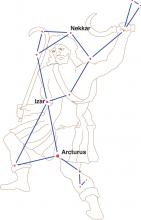You are here
Boötes, the Herdsman

Arcturus, the fourth-brightest star in Earth's night sky, is about 25 times larger than the Sun, and it produces about a hundred times as much energy. But Arcturus is nearing the end of its life. In astronomical parlance, Arcturus has moved off the main sequence and entered the "giant" phase of its life.
Despite its distance, Arcturus is one of the few stars to have its distance measured directly.
Careful measurements reveal the star’s apparent diameter — how big it looks in the sky. That’s then combined with measurements of its distance — about 37 light-years. The combination reveals that the star's true size.
What’s particularly important is that the measurement matches nicely with predictions of how big the star should be. Those predictions are based on models of how stars behave — how they produce energy, how they change as they get older, and so on. If the models are correct, then astronomers can make a few basic measurements of any star — such as its temperature and brightness — and use those to determine the star’s size, its stage of life, and much more. But it’s important to verify the models against stars with known distances. Most of those comparisons show that the models are spot on.
Astronomers used light from Arcturus to help trip a switch that opened the 1933 World's Fair in Chicago.



